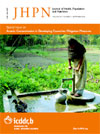
|
The Journal of Health, Population and Nutrition
icddr,b
ISSN: 1606-0997
EISSN: 1606-0997
Vol. 22, No. 2, 2004, pp. 203-211
|
 Bioline Code: hn04025
Bioline Code: hn04025
Full paper language: English
Document type: Research Article
Document available free of charge
|
|
|
The Journal of Health, Population and Nutrition, Vol. 22, No. 2, 2004, pp. 203-211
| en |
A Randomized Placebo-controlled Trial of Iron Supplementation in Breastfed Young Infants Initiated on Complementary Feeding: Effect on Haematological Status
Nagpal, Jitender; Sachdev, H.P.S.; Singh, Tejinder & Mallika, V.
Abstract
To combat iron deficiency manifesting around six months of age, iron-fortified complementary feeding has
been recommended. In developing countries, in view of the poor bioavailability of iron from predominantly
cereal-based diets and the high cost of fortification, medicinal iron supplementation is an
alternative intervention. This double-blind randomized placebo-controlled trial was conducted from April
1999 to March 2000 in the Out-patient Department of a tertiary hospital in New Delhi, India, to evaluate
the haematological effects of medicinal iron supplementation to breastfed young infants initiated on
complementary feeding. One hundred healthy non-low birth-weight, predominantly breastfed infants aged
4-6 months were randomized into two groups to receive either iron (2 mg/kg/day) (IS group; n=49) or
placebo drops (P group; n=51) beginning with the initiation of home-based non-fortified complementary
feeding. Haematological parameters and anthropometry of mothers and infants were measured at baseline
and repeated for infants after four and eight weeks of recruitment. Seventy-one subjects (35 in the IS group
and the 36 in P group) came for the first follow-up, and of these, 43 (19 in the IS group and 24 in the P
group) reported for the second visit. The adjusted (for maternal and baseline infant ferritin) serum ferritin
levels were significantly higher in the IS group at both the follow-ups (p=0.006). The adjusted (for
maternal ferritin and baseline infant ferritin) change in haemoglobin was significantly higher only at the
second follow-up (0.7 g/dL; 95% confidence interval [CI] 0.3-1.0 g/dL). The adjusted rise in haemoglobin
was higher in initially anaemic infants (at second follow-up by 1 g/dL; 95% CI 0.5-1.6 g/dL). Medicinal
iron supplementation, at the time of initiating complementary feeding, to breastfed young infants resulted
in an elevation of serum ferritin and haemoglobin. The response was higher in initially anaemic infants.
From a programmatic perspective, evidence needs to be generated on the relative merits of selective
(anaemic) versus general supplementation and daily versus weekly supplementation.
Keywords
Iron; Iron deficiency; Anaemia, Iron-deficiency; Complementary feeding; Infant; Double-blind method; Randomized controlled trials; India
|
| |
© Copyright 2004 - ICDDR,B: Centre for Health and Population Research
Alternative site location: http://www.jhpn.net
|
|
